#mushhushshu
Text
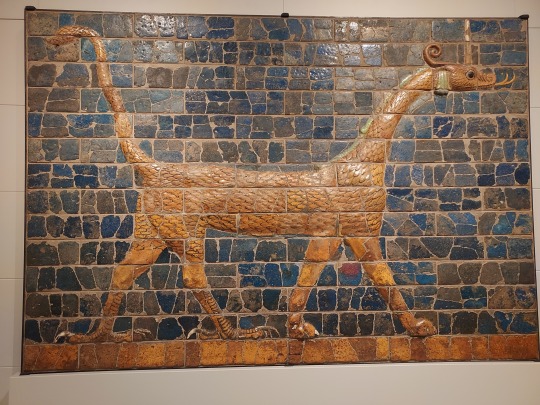
Mushhushshu-dragon, Symbol of the god Marduk, 604-562 B.C.E.
Glazed ceramic
Babylonian culture, Iraq
-----------------------------------------
The processional way leading to what is known as the Ishtar gate in ancient Babylon was built by the Babylonian king Nebuchadnezzar II between 604 and 562 BCE. It was lined with glazed bricks that formed panels depicting sacred animals: bulls, lions and "dragons." The dragon is actually a composite creature comprising a snake's head, a feathered lion's body, an eagle's hind legs, and a lion-scorpion's tail.
-Description from The Detroit Institute of Art
1 note
·
View note
Text

Mushhushshu
0 notes
Text

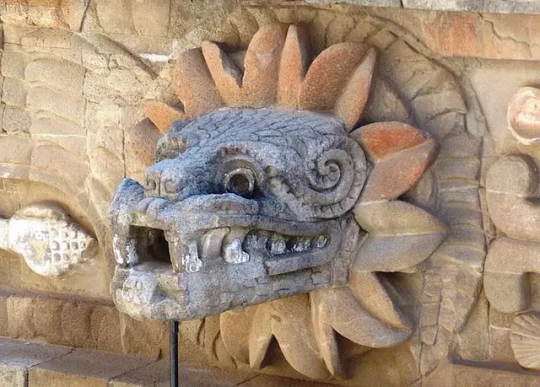
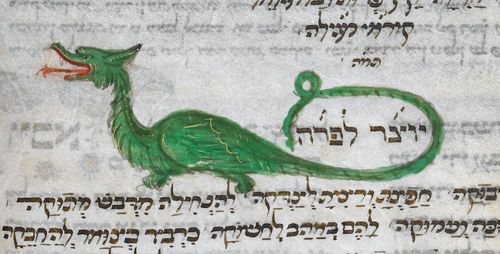
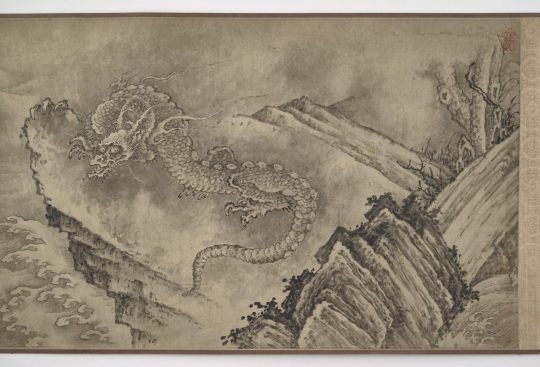

The Dragon Drags On
Though seldom seen today, dragons, of the genus Draconis, are some of the most famous creatures in the world, known for their size, ferocity, elegance, and supposed love for treasure. Though the exact number of dragon species is unknown, there are at least a dozen that are officially recognized; the real number is likely much higher. Once widespread, the range of this group has declined dramatically in the past centuries and populations are now believed to reside in only the most remote parts of the world. Most of what we know of dragons comes from historical records, and study of live specimens has proved impossible due to their rarity.
Because of their global distribution, dragons display a wide variety of morphological traits, including coloration, features, and even the number of limbs. However, some traits are common to nearly all species. Most dragons are thought to be brightly colored, often red, green, or blue; many species also have gold patterns in some form. As reptiles, dragons are covered in scales, though some also posses feathers or manes. Dragons also have extremely long, flexible tails which in some species may act as a supplementary limb. The body is generally long and serpant like, with the exception of the European Dragon and the mushhushshu, or Babylonian dragon. Though all species share an ability to fly, only the European dragon has a functional set of wings. The mechanics of flight for other species are unknown. The European dragon is also noted for its ability to breathe fire; other species such as the Chinese Dragon, or lóng, are more often associated with water.
All dragon species are believed to be carnivorous, though the content of their diet varies from region to region. Due to their large size, it is believed that they predate upon larger mammals such as cattle, sheep, camels, llama, deer, and even megafauna like elephants. Though they lack natural predators, their consistent targeting of livestock and game animals has in the past led dragons into conflict with humans; centuries of dragon hunting for sport and to protect agricultural interest has pushed the dragon to the brink of extinction.
Very little is known about the breeding habits of dragons. Like most large reptiles, they are believed to be solitary and fiercely territorial. It is also likely that they lay eggs, but whether parents provide any kind of care for their clutch or hatchlings is unknown. To date, no record of juvenile dragons has been found, indicating that the rate of survival to adulthood is extremely low. This may be due to predation on hatchlings by opportunistic animals, or adult dragons may attack and kill juveniles to defend their territory, or a combination of the two.
Although they are extremely rare today, dragons have been and continue to be important part of cultures around the world. Ancient civilizations such as the Aztec, Egyptians, and Mesopotamians all revered dragons as dieties. Many other cultures incorporated dragons into their folklore and mythologies, and in many parts of the world the dragon has come to symbolize power, changes in the seasons, or natural disasters, among other things. In more modern times, dragons have come to be associated with wealth, though there is no biological evidence for treasure-hoarding behavior.
Conservation status: Because no dragon species has been sighted for several centuries, they are largely believed to be extinct; however, the IUCN has yet to make a formal declaration. A few hopeful biologists believe that some species still survive in remote locations such as the deep Amazon rainforest or the mountains of Central Asia.
April Fools! I hope you enjoyed this departure from the usual content. I will be on hiatus until April 9th, as I'll be helping a friend with his field research. In the meantime, feel free to send in questions, commons, requests for a particular animal, or proof-of-donation submissions to help the people of Palestine; I'll respond to them all if I have spare time or when I get back!
Photos
A mosaic of a mushhushshu (Draconis babylonia) on the Ishtar Gate, constructed in the 6th century in Babylon; photo by Jan van der Crabben
A bust of an Amazonian dragon (Draconis quetzalcoatl) carved in 150-200 CE in Teotihuacan; photo via Wikimedia Commons
An illustration of a European Dragon (Draconis europa) from 15th century Italy, by the British Library
A Chinese dragon (Draconis qin) depicted as one of the eleven dragons in a Ming dynasty scroll, via the Smithsonian National Museum of Asian Art
A page from an illuminated manuscript of the Hamzanama, dated to the 16th century, showing a Persian dragon (Draconis mughal) via the Museum of Applied Arts in Vienna
103 notes
·
View notes
Text
ive been wanting to make a mushhushshugirl post for probably a year now at this point but you can only imagine how hard it is to find an opportunity to put a mushhushshu in something
3 notes
·
View notes
Text

mushhushshu-dragon, symbol of the god marduk, 604 - 562 BCE.
6 notes
·
View notes
Text
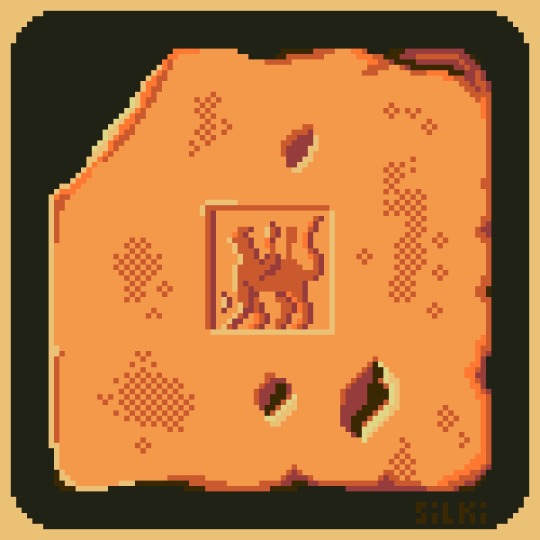
Only 4 days late for the Pixel Dailies’ baked' theme. A stamped and baked clay brick. The stamp shows the 'mushhushshu' dragon with the emblems of Marduk and Nabu on its back. Found in Nimrud, in Iraq. Dated to 630-627 BCE. Currently held in the British Museum, but not on display. First theme I’ve been inspired to do in a decent while.
[img ID: Pixel art of a worn, square, clay brick with a broken corner, coloured in shades of yellow, orange, and brown. In the middle of the the brick is a square showing a four-legged creature with a long tail, carrying two indistinct emblems on its back. /ID]
4 notes
·
View notes
Text

In ancient Babylon, the mushhushshu (pronounced “moosh-hoosh-shoo”) was a divine creature associated with Marduk, the main god of the city. “Mushhushshu” means "furious snake," but the animal’s body combines the head and scales of a snake, the claws of an eagle, the legs of a lion, and a tail ending in a scorpion’s stinger. This Mushhushshu was one of the protective animal figures on Babylon’s Ishtar Gate. Nearly five stories tall, and built to impress, the Ishtar Gate was part of the Processional Way, a ceremonial road leading into the walled city.
4 notes
·
View notes
Text
Mushhushshu: The Mythical Creature of Ancient Mesopotamia
Mushhushshu is an interestung mythical creature from ancient Mesopotamian mythology. It's depicted as a dragon or serpent with horns and a forked tongue. Fascinating!

View On WordPress
0 notes
Text
Mesopotamian Religion
December 10, 2015 (11 years old)
Sumerian religion flourished for a long time before it was swallowed up by the waves of time. During the era when this rich culture was in full bloom, the Mesopotamian built beautiful step-pyramid temples (ziggurats), and had wistful practices and beliefs. They believed in gods, goddesses, demons, and monsters, and had lots of interesting mythology. Sumerian religion was awesome and imaginative. It was definitely an essential part of mesopotamian life.
Religion was very important to the Sumerians. Especially their practices and beliefs of their religion. The mesopotamians believed that there was a patron god of each city that looked over it and gave people divine guidance. The symbol that represented each city-the standard-was a representation of the patron god. For example, the patron goddess of Uruk was Inanna. The symbol representing Inanna was a bundle of reeds, and consequently the standard of Uruk was the same thing (Shuter). This was important because the kings would build and maintain a kind of a step-pyramid temple created for the gods (mainly the patron god) as a place of worship. It was conveyed as the gods connection to earth (Shuter, Service). Citizens would leave figurines of people sitting in a praying position with large, hopeful eyes in hope that the flattered god would grant their wish, question, or favor while the person worked (Service). A priest or priestess would then carry the message from the “god” to the citizen (Pofahl). Priests and priestesses were very powerful people because of their connection with the gods. The priests and/or priestesses would give offerings of food which the god would “eat” (Shuter). This is important because if there were no priests or priestesses there would be no king because he is actually a high priest (Pofahl). Without a king, there wouldn’t be any laws, so there wouldn’t be any reasons for advances in technology. So, they would have no stable food supply or communities. Interestingly, they believed in the afterlife like ancient Egyptians. People were buried with their servants, pets, and belongings for the afterlife (Shuter, Service). This shows the link in later religions to this main first religion. Lastly, the Sumerians believed that animals would tell the future with their actions. This information shows that most Mesopotamians were superstitious. In the end, the practices and beliefs of Mesopotamian culture is very important to their religion
Religion is one of the most important aspects of Mesopotamian culture. They believed in gods, goddesses, demons, and monsters, and had lots of interesting mythology. They had hundreds of gods, goddesses, demons, and monsters (The British Museum). The gods and goddesses acted a lot like people. they ate, drank, had feelings, and murdered each other. Their Mesopotamian name was “dingr”. All of the dingr controlled four forces of the universe. Here are a few: Enki(the water god), the guardian of me, aka the organic universe. There is Enlil(the air god), who created me. This is important because otherwise the myths would have less meaning. There were other dingr like Utu(the sun god), who travels across the sky each day in a chariot, and Nanna(the moon goddess), who travels across the sky each night in a boat. This is interesting, because it seems as if Greek mythology was based off of this (Pofahl). Inanna was the dingr of love and war, and in depictions of her, she is shown with a lion at her feet. She has also been represented by a bundle of reeds (Shuter). A dragon called Mushhushshu(or Sirrush) was the guardian of all of the important dingr, such as Marduk, Enlil, Ashur, and Nabu. These gods sometimes rode on Mushhushshu. Marduk became important because he had slain Tiamat, a goddess with dark ambitions to kill all the other dingr. In attempt to kill the others, she created demons and monsters. But Marduk was able to chop her in half. Her upper-half fell and became the earth, and from her eyes came the Tigris and Euphrates rivers, while her tail-end became the heavens. Marduk then became the creator god (The British Museum). This is important because otherwise Marduk wouldn’t be important and Mushhushshu would cease to exist because Mushhushshu is Marduk’s symbolic animal. These two are some of the most recognisable carvings on temples, as the Ishtar Gate is almost completely covered by depictions of Mushhushshu. In the end, gods, goddesses, demons, and monsters are essential to Sumerian religion.
Religion was a beneficial part of Mesopotamian society, and without it, this first civilization would have ceased to exist. Their practices, needing priests, would have not existed. The king of each city-state is a priest, so there would be no king. There would be nobody in charge, and the laws would dissipate. There would be feuding, and people would be no better off than when they were starving in the foothills of the Zagros mountains. Ziggurats would disappear, all religious stories gone. By judging how the Sumerian mythology affected other cultures, their religions would go wonky, and Earth wouldn’t nearly be the same. Here’s a question for you to think about this in your spare time: what would be different in our world today if Mesopotamian religion hadn’t existed?
Bibliography
•The British Museum. Dec. 14, 2015. www.mesopotamia.co.uk
•Pofahl, Jane. Ancient Civilizations:Mesopotamia. T.S. Denison & Co., 1993.
•Service, Pamela. Mesopotamia.Marshall Cavendish, 1999.
•Shuter, Jane. Excavating the Past:Mesopotamia. Heinmann Library, 2006.
0 notes
Text



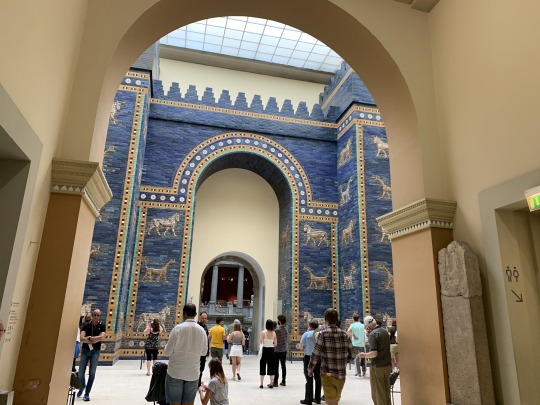
The Ishtar Gate of Babylon, reconstructed in the Vorderasiatisches Museum, Berlin
Molded and glazed brick
Neo-Babylonian, reign of Nebuchadnezzar II (604-562 BCE)
From Nebuchadnezzar’s inscription:
“With the filling of Babylon’s street, both the city walls’ entrances (at the Ishtar Gate) became increasingly low. I cleared away those gates; and I laid their foundations opposite the water with bitumen and baked bricks, and I had them artfully made with shining lapis lazuli baked bricks on which wild bulls and mušhuššu dragons were created. Mighty cedars I spread for their roofing. I installed door leaves of cedar wood covered in bronze and thresholds and door jambs made of copper into its gates. Fierce wild bulls of copper and raging mušhuššu dragons I set at their thresholds. I filled those gates with splendor for the wonder of all people.”
(translation from the exhibition catalogue A Wonder to Behold: Craftsmanship and the Creation of Babylon’s Ishtar Gate, edited by Anastasia Amrhein, Clare Fitzgerald, and Elizabeth Knott, 2019)
#babylon#Ishtar gate#babylonian#neo-babylonian#Nebuchadnezzar ii#marduk#mushhushshu#mushussu#art history#ancient near east#mesopotamia#ancient art#vorderasiatisches museum#Pergamon museum#staatliche Museen zu berlin#museum
296 notes
·
View notes
Photo

Mushhushshu Plaque
This terracotta plaque was used to protect households from enemies. 800-500 BCE. From Southern Mesopotamia, modern-day Iraq. (British Museum, London)
source Ancient.eu
19 notes
·
View notes
Photo

This was amazing! #Mushhushshu from @rhinegeist a beautiful dark ale blend aged 10months in bourbon barrels with coffee, chocolate and vanilla!!! Wow! /// #beerconspiracy #beergeek #beerporn #beer #instabeer #craftbeer https://www.instagram.com/p/B1zoQZjl1u4/?igshid=15h84zyrui5nf
0 notes
Photo

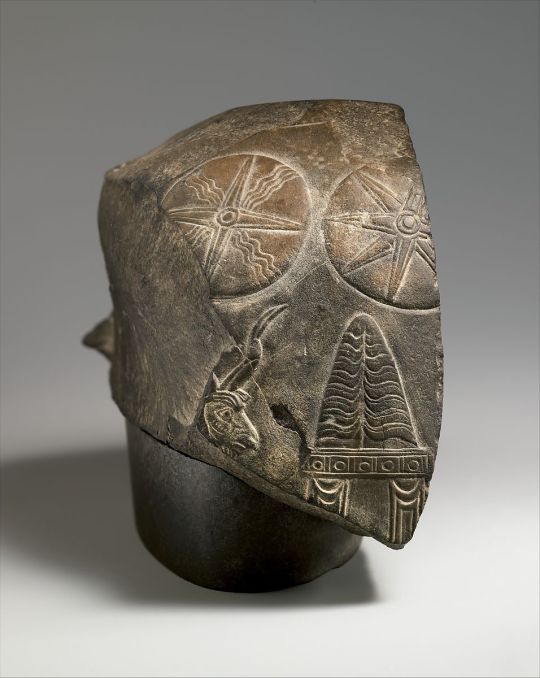
Top fragment of a kudurru with a mushhushshu dragon and divine symbols ca. 1156–1025 B.C.
Known as kudurrus or narus, a distinctive group of Babylonian stone monuments were once thought to be boundary markers placed in fields. In fact they are more likely to have been placed in temples, where their contents were preserved and sanctified. The monuments, often made from polished black limestone, are usually uneven and boulder-like in shape. They carry inscriptions describing grants of land, often from the king to a high official. Around the text are placed divine symbols, which act to protect and guarantee the gift.
Kudurrus first appear in the second millennium B.C., during the period of Kassite rule in Babylonia. This fragmentary example dates to the 12th century B.C. The surviving piece, which comes from the top part of the kudurru, shows part of the body of a snake coiling round the upper surface. Below the snake is a mushhushshu, a composite dragon associated with Babylon’s chief deity, Marduk, and his son Nabu. The mushhushshu faces a temple façade or altar on which stands a spade symbol, also associated with Marduk. Below these can be seen a very small section of the original inscription. The other side of the stone shows astral symbols representing the sun (the sun-god Shamash) and Venus (the goddess Ishtar), as well as another stylized temple-façade, this time with a horned crown (a symbol used for the sky-god Anu and the great wind god Enlil). Also visible is part of a goat-fish, associated with the god Ea.
Period: Second Dynasty of Isin
Date: ca. 1156–1025 B.C.
Geography: Mesopotamia
Medium: Limestone
Dimensions: H. 6 1/2 x W. 4 x D. 7 1/4 in. (16.5 x 10 x 18.4 cm)
28 notes
·
View notes
Photo

Been a long day... #rhinegeist #mushhushshu #darkale #barrelaged #properglassware #ohiobeer #instabeer (at North Royalton, Ohio)
0 notes
Photo

Top fragment of a kudurru with a mushhushshu dragon and divine symbols via Ancient Near Eastern Art
Medium: Limestone
Rogers Fund, 1985 Metropolitan Museum of Art, New York, NY
http://www.metmuseum.org/art/collection/search/327048
520 notes
·
View notes
